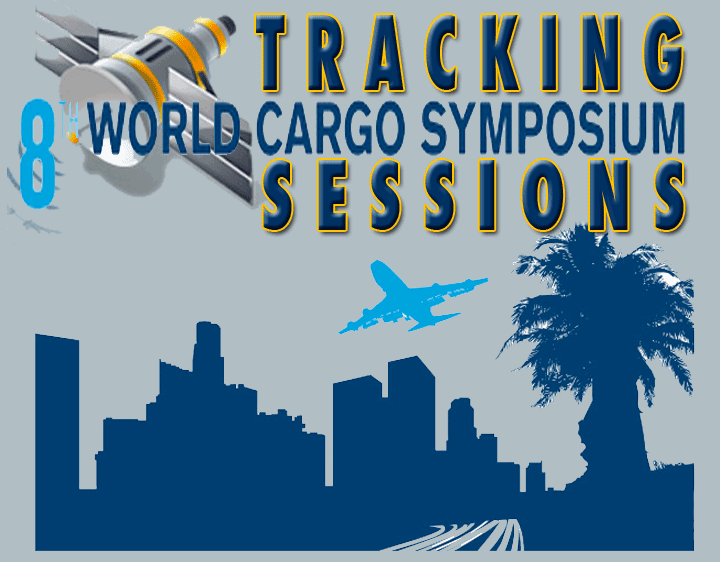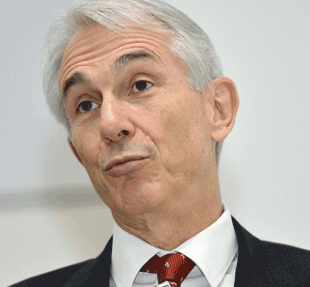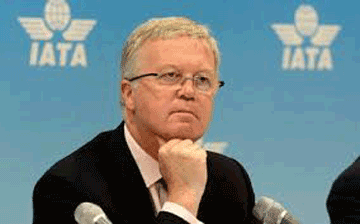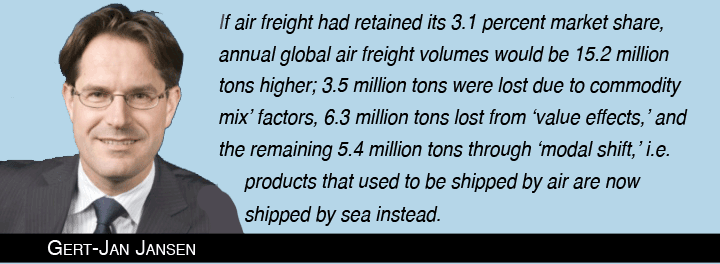|

Exclusive—FlyingTypers
provides unique insight into the WCS Sessions. Did IATA WCS Sessions deliver?
 “It
would have been good to have seen Tony Tyler (left) as a keynote speaker
at World Cargo Symposium,” said Patrick Murray, Head of Calogi and
IT Guru, as he recalled IATA Cargo Week in Los Angeles in March. “It
would have been good to have seen Tony Tyler (left) as a keynote speaker
at World Cargo Symposium,” said Patrick Murray, Head of Calogi and
IT Guru, as he recalled IATA Cargo Week in Los Angeles in March.
“As ever, the presence of the IATA
top executives no doubt clearly underlines IATA’s commitment to
the cargo business.
“I think it’s fair to say that
we missed him.”
We asked Patrick to describe his take on
the other WCS opening presentations.
“It’s great to see AA’s
commitment to e-AWB.
“With a force like AA behind the e-AWB,
the chances of success are substantially increased,” Patrick Murray
said, adding, “Education sessions and workshops can only help the
cause.”
Smith’s
Message
 “Fred
Smith’s message is much more sobering,” Patrick (right) said. “Fred
Smith’s message is much more sobering,” Patrick (right) said.
“Added to the existing threats of
decreasing yields, unprofitable freighters, jet fuel prices and market
share erosion, our industry is now faced with an additional challenge
of protectionism.
“Given the decline of airfreight in
terms of the revenue mix, it is also worrying that if we continue to see
the same percentage declines that we are currently experiencing, by 2030
we will see the integrators at 18 percent, air cargo at 12 percent, and
ocean at 70 percent.
“The alarm bells should be going off
right now.”
Des All Folks!
IATA Head of Cargo Des Vertannes offered
a rundown of the achievements to date—a shot list that skimmed the
past twelve months since World Cargo Symposium last was mounted.
“Bear in mind,” Patrick observes,
“that these are industry achievements and we are all responsible
for making these happen.”
But we point out that several people we
spoke to indicated that they were disappointed with the 22 percent e-AWB
target for this year.
“I guess,” Patrick Murray said,
“that this is based on the lower-than-expected penetration achieved
for 2013.
Des Vertannes declared, “It’s
once again worth noting that these targets are set by the IATA Board of
Governors, the airlines, and therefore if we fail, it’s down to
us, the industry, to move the ball.
“In 2011 we set a goal for 15 percent
e-AWB usage by the end of 2012, 70 percent by the end of 2013, and 100
percent usage the year after, We need to do much, much more..
Tracking
The Sessions
 Andreas Raptopoulos, the CEO of Matternet,
described the problem his company is trying to solve: one billion people
have no access to all-season roads, making transportation of goods extremely
difficult.
Andreas Raptopoulos, the CEO of Matternet,
described the problem his company is trying to solve: one billion people
have no access to all-season roads, making transportation of goods extremely
difficult.
For example, there are many remote places
in Canada where it’s challenging to transport anything in the winter.
Matternet wants to connect unmanned aerial vehicles (UAVs), which travel
short distances, into a bigger network called Matternet in order to meet
the world’s transportation needs.
Every UAV would be able to land at a station
and swap a load and battery without human intervention.
Even where there is reliable infrastructure
roads can be highly congested and the solution offers a viable alternative.
Andreas proceeded with a demo where he actually
flew a drone in front of the audience carrying a two-kilo parcel.
There are a few challenges to making a drone
network a reality, including reliability, safety, and airspace management
concerns.
The costs savings, however, can be fantastic.
Flying a 2kg parcel 20kms costs around 24 cents.
Show Me The
Money
Following Andreas’s presentation,
Brian Pearce, the IATA money guy and chief economist, offered a presentation
called “Weak World Trade and On-shoring: permanent or temporary?”
 It was Pearce-ing news from the IATA chief
economist as he talked about statistics in the airfreight industry.
It was Pearce-ing news from the IATA chief
economist as he talked about statistics in the airfreight industry.
Up until recently, he noted, cargo revenues
have moved in line with passenger revenues; however, the last three years
have shown a different trend with the gap widening in favor of the passenger
business.
Revenues, which were expected to reach US$20
billion more than they did today, did not materialize.
Brian observed that e-commerce, which is
transforming the retail business (e-tailing), is also critical for airfreight.
A new challenge for the air cargo industry
is also weaker world trade, partly due to protectionism and partly because
of policies focused on buying locally to protect jobs at home.
A new threat to the air cargo industry,
known as ‘on-shoring,’ has been born.
Fuel efficiency, Pearce pointed out, and
carbon-neutral growth are key issues over the next few years, with the
risks being imposed costs on our industry from governments and regulators.
Well, if at every conference you can learn
something, then IATA WCS fit the bill.
According to Brian Pearce, it appears we
now have another threat to the industry, onshoring, which can now be added
to the existing threats of decreasing yields, unprofitable freighters,
jet fuel prices, market share erosion, and protectionism.
One truly wonders what else lies around
the corner and how the industry can respond to so many pressures?
In any case, our ever-confident Patrick
Murray sees some light.
“It’s good that the IATA chief
economist recognizes the importance of e-commerce to our industry,”
Patrick Murray said.
Word
Up
Finishing on an upbeat note, Brian said
there are encouraging signs, such as improved business confidence and
the demand cycle turning up.
Seabury Shifts
Gert-Jan Jansen, Executive Director, Seabury
Group, presented the details of a comprehensive mode shift study analyzing
shipper trends in transportation decisions.
Modal shift has cost the air cargo sector
around five million tons of cargo per year—around 10 percent of
total global volumes—and looks set to continue.
 |
Modal shift, we learned, had
been taking place since 2000, had slowed down during the crisis years
of 2008 to 2010, and accelerated from 2011 to 2013.
The survey indicated that most forwarders
and shippers surveyed expected modal shift to continue, but at a slower
rate.
Seabury said shippers and forwarders believed
the modal shift could be reversed by offering cheaper rates and more products,
and by developing closer relationships with shippers, multimodal solutions,
and improved reliability.
The truth is that Gert-Jan Jansen’s
presentation merely underlined what we already know: we are currently
losing market share to other forms of transport.
FlyingTypers thinks recovery has
to be led by listening to our customers.
This in itself could be a good track for
the next WCS.
Here are some ideas:
How does air cargo, as an industry:
1. Offer cheaper
rates?
2. Develop
more products?
3. Develop
closer relationships with shippers?
4. Offer multimodal
solutions?
5. Improve
our reliability?
We asked Patrick Murray.
“Lots of answers spring to mind, and
once again we have many existing solutions to the above. Our immediate
thoughts are to reduce costs by implementing e-cargo solutions and pass
the savings to customers.
“The industry needs to look at what
the integrators are doing: door-to-door, guaranteed delivery.
“Imitation is the sincerest form of
flattery.”
Tracking
Trends at WCS
Gert-Jan Jansen, Executive Director, Head
of Cargo Advisory Practice, Seabury, also presented the industry outlook
for 2014.
Fashion and raw materials achieved the highest
growth rate in 2013 (11 percent).
High-tech cargo lost ground over the same
period, mainly computers and semiconductors, with China contributing to
more than a third of the world’s losses in high-tech exports.
It’s no secret that the growth of
cargo capacity would be driven by the continuing arrival and deployment
of passenger aircraft, with the Asia-Pacific carriers having the majority
of capacity on order.
When the discussion turned to freighters,
the consensus was that despite the growth of belly capacity, the main-deck
aircraft would continue to play a major role for the foreseeable future.
Emerging
markets felt the slowdown in global economic growth in 2012 but generally
continued to grow at a faster pace than traditional developed markets.
However, the growth in trade came from emerging market to emerging market.
Developed countries saw a slow down in trade both from other developed
countries and from emerging countries.
Vietnam and Bangladesh stand out as two
of the fastest-growing trading economies.
Meanwhile FedEx placed the most freighter
orders over the past five years with 51, many of them replacements.
Large and medium freighters are increasingly
flying shorter sectors as they “vacuum clean” for cargo.
The full-range capabilities of these aircraft
are not being exploited, Seabury noted.
The conventional belief that the cargo industry
will grow at an annual rate of 5-6 percent per year in a strong economy
appears to be unfounded.
Furthermore, instead of growing at twice
the GDP, since 2010 it has only been growing at one time the GDP.
At the same time passenger traffic has enjoyed
a consistent recovery since mid-2009, while cargo recovered quickly in
2010 before falling back and stagnating.
In terms of industry measurements, RPKs
(Revenue Passenger Kilometers) continue to rise much faster than FTKs
(Freight Ton Kilometers). AFTKS, Available Freight Ton Kilometers, are
also outstripping FTKS.
Boeing Info
Blizzard
 Russell
Tom, Regional Director of Marketing, Boeing, spoke of the increase in
ocean traffic affecting all-cargo operations and where Boeing sees growth
and opportunities for its freighter productions. Russell
Tom, Regional Director of Marketing, Boeing, spoke of the increase in
ocean traffic affecting all-cargo operations and where Boeing sees growth
and opportunities for its freighter productions.
He said that main deck’s share of
cargo continues to remain steady at about 60 percent.
Boeing figures that the world’s freighter
fleet would increase from 1,730 to 2,300 by 2032.
The lower holds of passenger aircraft cannot
accommodate the demand.
No surprise that Boeing believes that freighter
airplanes are crucial to the overall health of the air cargo industry.
Dedicated freighters provide reliable capacity
to shippers of general cargo, mail, and express packages, and cargo that
cannot be accommodated in passenger airplane lower holds.
The significant efficiency and capability
advantages of large freighters will enable carriers to manage projected
traffic growth without increasing the number of airplanes proportionately.
The world’s 30 largest carriers that
use both passenger and freighter aircraft carry 46 percent of their cargo
on freighters. Production freighters will continue to play an important
role because their superior reliability, operating cost, and capability
can outweigh the significant on-ramp acquisition cost advantages enjoyed
by conversions.
Continuing a trend of many years in the
Asia Pacific region, all-cargo and combination carriers will take the
greatest number of large freighters, which are uniquely suited to long-haul,
intercontinental markets.
Express carrier networks will take the majority
of medium wide body freighters, ideally sized to support high-yield, time-critical
operations.
Standard-body freighters will serve emerging
regional and niche markets, as well as express markets, Boeing reports.
All This
Is That
We thank Boeing for the information.
The growth of emerging markets is interesting.
FYI, many people are aware of the great
potential in both Bangladesh and Vietnam, and speaking to Patrick Murray
elicits the remark that “we are already working with the industry
in both countries to automate their processes.
“Bangladesh remains an issue for us
as many airlines still continue to issue pre-printed stock, whereas moving
to neutral air waybills will really help the e-cargo cause,” Patrick
Murray said.
“If we can eradicate this practice,
not just in Bangladesh, but in other markets where this practice continues,
we can put in place one of the building blocks for e-cargo,” he
added.
Explain The Numbers
A thought that occurred to us after the
Boeing presentation was whether the AFTKs mentioned included the aircraft
being purchased by non-cargo carrying low cost carriers.
It would be good to know if these airlines
were excluded from the count.
Freighters On The Half Shell
The never-ending conundrum of freighter
viability continues.
The daily utilization rate (hours flown
per day) of freighter aircraft was between 9.5 hours and 10 hours before
the global financial crisis, which then plummeted to around 8 hours in
2009.
After recovering sharply to a new peak of
more than 10 hours in mid-2010, it fell dramatically to well below nine
hours at the end of 2012.
These statistics support the ‘vacuum
cleaner’ approach adopted by some airlines, but reduces the productivity
of the aircraft.
Land of Opportunity
 The
Land of Opportunity session offered valuable guidance on building business
in emerging new markets in Asia, Africa, Latin America, and elsewhere. The
Land of Opportunity session offered valuable guidance on building business
in emerging new markets in Asia, Africa, Latin America, and elsewhere.
Marco Bloemen said that China and Brazil
would continue to offer opportunities, while Bangladesh and Vietnam are
also growth markets.
He noted that air cargo markets can change
quickly due to production shifts and newly created airfreight flows.
China is responsible for the highest absolute
freight growth, but with it comes certain risks.
Changes in China’s trading patterns
affect the entire world.
BRIC &
MINT
We spoke to conferees about Brazil and Mexico.
Brazil is part of the well-known BRIC acronym,
which includes Russia, India, and China, but a lesser-known fact is that
Mexico is part of MINT—Mexico, Indonesia, Nigeria, and Turkey.
We learned that both Brazil and Mexico face
similar challenges such as infrastructure, but investment projects are
in the pipeline.
Brazil will spend nearly $15 billion over
the next 20 years upgrading its airports.
While trade liberalization, prudent fiscal
policy, and innovative social programs have helped reduce poverty and
income inequality in Brazil, there is still some way to go.
Migration Well Noted
“Many manufacturers have moved production
from China to India or Vietnam,” Patrick Murray notes.
“It’s also noticeable that in
the past few years, several companies have returned to Mexico.
“I understand that an airfreight shipment
from China to the United States that costs $20,000 will cost in the region
of $7,000 from Mexico, making Mexico an attractive proposition.”
So we wonder where this all goes as labor
costs are rising in coastal China, and many manufacturers are shifting
production to the country's inland regions, Asian countries west of China,
Africa, and South America, particularly Brazil.
Interest (minus the political upset) is
also growing in Russia.
Youri Takes A Stand
 A
brief conversation with Youri Busaan, (left) CEO, AERCO Airports of Congo,
was revealing A
brief conversation with Youri Busaan, (left) CEO, AERCO Airports of Congo,
was revealing
We had both identified that in many cases
traditional cargo is travelling as excess baggage.
A trader can ship the goods on the same
aircraft on which he is travelling, and clear them immediately upon arrival
through the passenger customs authorities.
So in the time it takes to unload and check
shipments into the cargo terminal, the goods transported can be customs
cleared and on sale.
As most of us are aware, excess baggage
is an expensive means of transporting goods. Obviously traders feel this
is a price worth paying.
The goal of cutting up to 48 hours off the
average end-to-end time of a consignment may not be enough.
Perhaps there is a market for handlers to
offer premium unloading, handling, and Customs clearance services.
Final Thoughts
On Los Angeles WCS
The 8th IATA World Cargo Symposium came
and went and it drew the very best in the cargo industry.
Meanwhile, airfreight’s share of the
market continues to slide, yields are down, and a host of other factors,
some existing, some new, continue to affect our great business. Without
a doubt at this time all of us are tasked with bringing new talent into
the industry.
What a challenge.
No one would argue that success breeds success
and new talent would be more likely to join a growing and profitable industry.
Given what we heard during the WCS, it’s going to be a tough sell.
We saw the e-AWB target being revised downwards
to 22 percent when we were initially targeting 70 percent this year.
 As reported in this story earlier, this
is a great disappointment to everyone who has tried so hard to make this
happen.
As reported in this story earlier, this
is a great disappointment to everyone who has tried so hard to make this
happen.
“It’s hardly surprising,”
said Patrick Murray, “that shippers still see cost as a barrier
to air cargo recovery.
“In one of the sessions, Cristo van
der Meer (right) of FloraHolland said a large portion of the cost of flowers
comes from air cargo.
“Without airfreight, the company can
cut 30-40 percent of costs.
“The number one priority to return
to the ‘Halcyon Days’ that Fred Smith alluded to in his keynote
this year at WCS and to reverse the trend of air freight decline, according
to shippers and forwarders, is for airfreight costs to come down.
“To do this, as an industry we need
to reduce our costs.
“Let’s face it,” Patrick
Murray said, “we can no longer afford to carry paper or engage in
paper-based processes.”
Thought Finale
 We heard the phrase “game changer”
mentioned several times during the week.
We heard the phrase “game changer”
mentioned several times during the week.
Des Vertannes said:
“Game-changing innovation is sorely
needed in air cargo.
“Our industry has been mostly stagnant
since 2008.
“We face significant challenges in
the areas of efficiency, security, and sustainability and the entire industry
needs to commit to new innovative processes if we are to benefit from
any economic upturn.”
We think part of the problem with big conferences
could be the reluctance to share ideas in an open forum and join together
to really resolve the industry problems that we heard so much about during
last week.
FlyingTypers believes that many
shy away from making the investments required to return the industry to
its “Halcyon Days” (Integrators excluded, of course).
We recall that in 1987 nine European carriers
joined together to develop the Galileo CRS solution to counter the high
market penetration of the Sabre and Apollo systems.
Looking
For Mr. & Ms. Goodcargo
Is there a ‘game-changer’ out
there who can rally the industry and enable us to get air cargo growth
back on track with an affordable action plan?
All that being said, with over 1,000 delegates,
the IATA WCS was a great place to network overall.
Geoffrey/Sabiha
|


